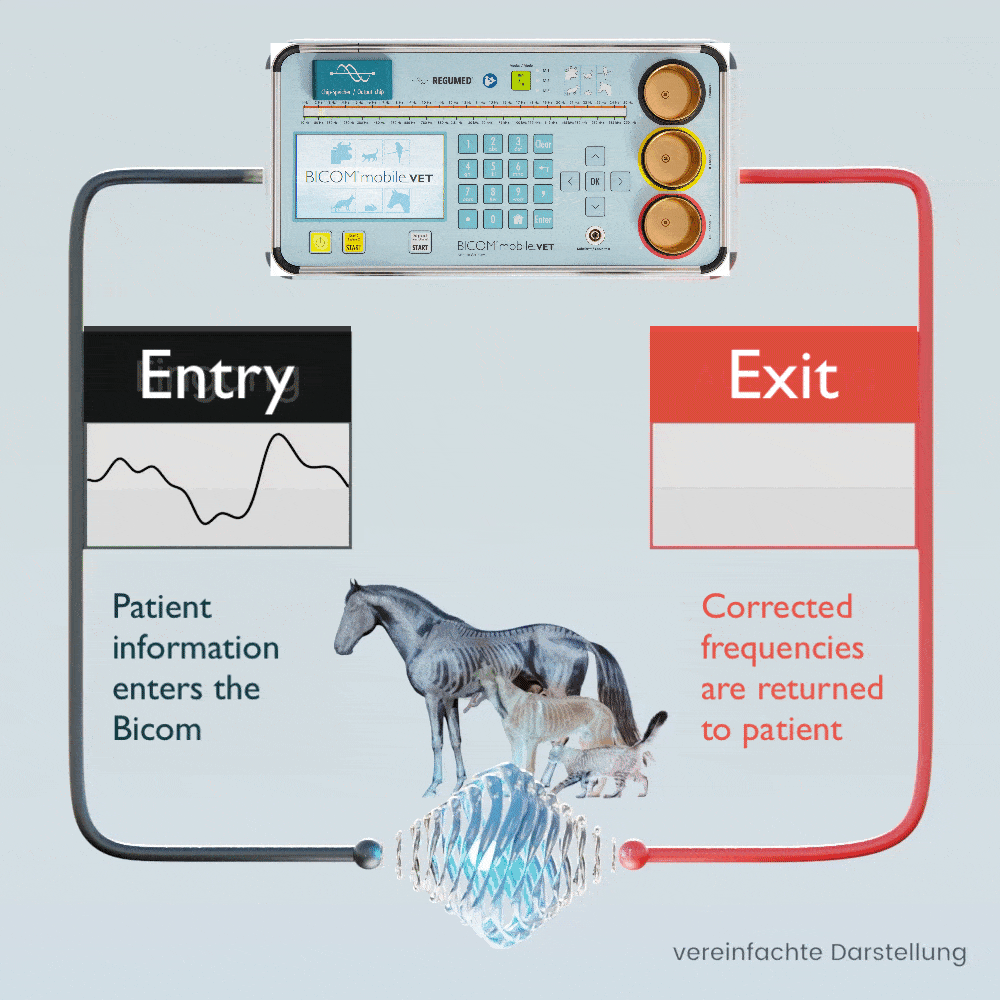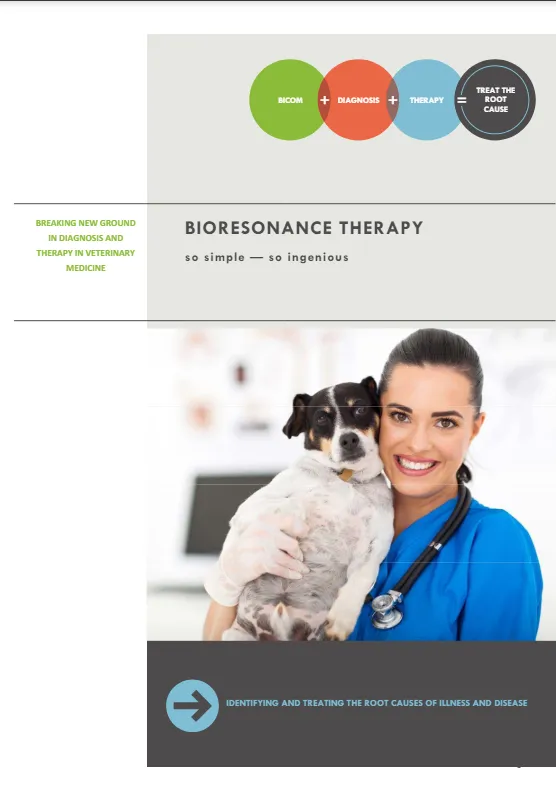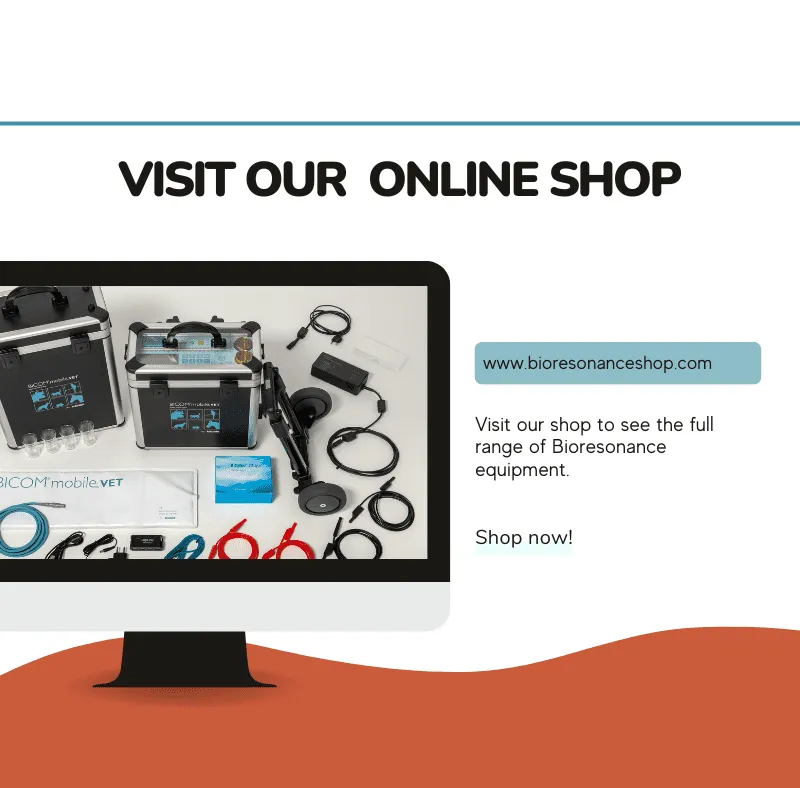Treatment with the help of the patient’s own information
in the BICOM® mobile VET bioresonance device
In contrast to other “frequency therapy devices”, BICOM® bioresonance is a method that is highly individual and perfectly tailored to the needs of the patient through the use of the patient’s own information and the possibility of testing specific wave patterns for resonance.
The patient’s own pathological and physiological information is recorded using special applicators and fed into the BICOM® mobile VET.
Depending on the therapy program, the specific wave pattern as a carrier of information is amplified, weakened or inverted and transmitted back to the patient in modulated form, which means that the transmission of information changes in clarity depending on the modulation or it disappears completely.
The treatment signals continuously adapt to the changing pathological situation of the patient. As the therapy progresses, the body’s ability to regulate is reactivated.
Find out more about this topic at our regular events. Together with veterinarians and animal naturopaths, we offer various face-to-face and online events .
The BICOM® bioresonance method is a cause-oriented, holistic treatment concept. It can narrow down the cause of the health problem in animals and find out even the hidden causes of the clinical picture.
Animals have a natural regulatory system that can also compensate for unusual influences. However, even good self-healing powers eventually reach their limits. Persistent exposure to allergens, environmental toxins, fungi, viruses, bacteria or stress and changed living conditions weaken the immune system and are often the cause of an illness. In particular, fungal infestation on the skin or chronic diseases in general are not always due to a breeding-related genetic defect, but are signs of a disturbed immune system.
The BICOM® bioresonance method is the key to successful diagnosis and therapy, especially for animals that cannot tell us exactly where it hurts or what the symptoms are. It is a gentle form of therapy that can be carried out without side effects and without additional stress for the animal.
The BICOM® mobile VET records the bioenergetic state of the animal, processes the information it contains and returns modified vibrations / therapy frequency patterns to the animal. Symptoms and stress can be diagnosed and targeted therapy can be initiated.
Through the use of endogenous and exogenous substances, the body’s own self-healing powers can be activated and imbalances that have existed for a long time can also be regulated.
REGUMED Medizintechnik are pioneers of the BICOM® bioresonance method. More than 30,000 therapists worldwide, well over 10,000 of them in Germany, successfully use their therapy concept.

Biophysical basics of the bioresonance method
Life is only possible when three conditions are met: matter, energy and information.
We also find these aspects in conventional medicine, both in diagnostics and in therapy. For example, every drug is also a carrier of information.
Information is neither energy nor matter, it is immaterial and comparable to the meaning of a message from a sending to a receiving system.
In addition to the electrical processes in the receptor proteins and biomembranes in general, electromagnetic interactions through light (biophotons) also play a role in cell communication and the transmission of information.
Specific electromagnetic wave patterns act as information carriers. These wave patterns can be modulated by the BICOM® device in order to eliminate disturbing or stressful information in an organism.
The goal is to restore the free flow of healing information (cell communication) and thus support the self-regulation of the organism and the self-healing powers.
Individual, patient-specific information or information from native substances, digitized substances or information stored on storage media can be used for therapy.
What your colleagues are saying…

Unlocking Wellness: Exploring the Benefits of Biofeedback Therapy
In a world where alternative therapies are gaining mainstream recognition, biofeedback therapy stands out as a beacon of hope for many grappling with chronic health conditions. Once nestled quietly in the corners of alternative medicine, this unique type of therapy has blossomed into a widely respected approach in modern healthcare.
Biofeedback therapy hinges on the fascinating concept of gaining control over bodily functions that are usually involuntary, like heart rate and muscle tension. This evolution from a niche method to a scientifically backed treatment is remarkable and speaks volumes about its efficacy.
Check Out: Bioresonance therapy
What is Biofeedback?
Biofeedback merges physical and mental health practices to enhance overall well-being. At its core, biofeedback enables individuals to learn to control certain body functions usually regulated automatically by the body, like heart rate or muscle tension.
Biofeedback therapy involves sensors attached to the body, which gather information about physiological activities. This data is then relayed back to the individual via a computer screen, allowing them to gain awareness of these internal processes.
Among the various types of biofeedback, three stand out: EEG, EMG, and Thermal.
EEG biofeedback, or neurofeedback, focuses on brain wave activity and is often used to treat conditions like attention deficit hyperactivity disorder (ADHD) and high blood pressure.
EMG biofeedback focuses on muscle activity and is beneficial for conditions like urinary and fecal incontinence, helping individuals to strengthen their pelvic floor muscles.
Thermal biofeedback measures skin temperature, reflects blood flow and stress levels, and can effectively reduce relaxation and stress.
Biofeedback helps people gain greater control over their bodies, leading to improved health outcomes without the negative side effects often associated with medication.
Common Applications and Treatments:
Biofeedback is a type of therapy that harnesses the power of our minds to influence body functions. This versatile approach treats various health conditions, each benefiting from its unique, non-invasive methods.
Chronic Pain and Biofeedback:
Biofeedback training can be a beacon of relief for those suffering from chronic pain. By learning to control physiological responses, patients can manage pain more effectively.
Biofeedback for Heart Health:
High blood pressure, a common yet serious condition, can be managed through biofeedback. Patients learn to moderate their stress responses, which can positively affect blood pressure levels. Regular biofeedback sessions have been found to help in maintaining heart health.
Urinary and Fecal Incontinence:
Biofeedback is a game-changer in treating urinary and fecal incontinence. Pelvic floor muscle training with biofeedback strengthens the pelvic floor muscles, providing significant improvement for people with fecal incontinence.
Neurofeedback and ADHD:
Attention Deficit Hyperactivity Disorder (ADHD) patients can benefit from neurofeedback, a branch of biofeedback. This approach helps improve concentration and reduce impulsivity by training the brain to respond differently.
Each application demonstrates biofeedback's broad range and efficacy, making it a viable option for improving various health concerns.
The Biofeedback Session: What to Expect:
During a biofeedback session, the therapist plays a crucial role. A trained biofeedback practitioner guides you through the process, ensuring you're comfortable and understand each step. They are skilled in applied psychophysiology and biofeedback, making them adept at interpreting the data from biofeedback equipment.
A typical session involves attaching sensors to your body. These sensors monitor physiological responses like heart rate or muscle tension. It's a non-invasive method used to treat various health concerns, including stress and chronic pain. The session usually lasts about an hour; you need about 10 sessions for effective results.
The data collected makes biofeedback work. Your therapist will help you understand these readings. For example, they might show how relaxation techniques can reduce stress indicators or how mental exercises can improve health. This understanding is vital as it empowers you to use biofeedback for self-regulation and wellness.
Biofeedback Equipment and Technology:
Biofeedback equipment has evolved remarkably, offering professionals and individuals engaging in applied psychophysiology and biofeedback a range of sophisticated options. Modern biofeedback devices are integral in monitoring physiological functions, a crucial aspect of biofeedback therapy. These sensors, often compact and user-friendly, can easily be used in clinical settings by biofeedback practitioners and therapists, enhancing the effectiveness of the treatment.
The accessibility of biofeedback technology extends beyond clinical environments. Many people are now exploring biofeedback as a form of alternative therapy at home. This shift has been instrumental in making biofeedback treatment more accessible to those dealing with health concerns like chronic stress or constipation.
Home-based biofeedback devices, though simpler than their clinical counterparts, still offer valuable insights into one's physiological state, enabling users to engage in mental exercises and relaxation techniques effectively.
Who Can Benefit from Biofeedback?
Biofeedback, a complementary therapy, has shown remarkable efficacy in treating various physical and mental health concerns. Ideal candidates for biofeedback are those seeking alternative therapy for chronic conditions like constipation, chronic obstructive pulmonary disease (COPD), or mental health issues stemming from chronic stress.
Biofeedback treatment can significantly benefit individuals with fecal incontinence, helping to strengthen pelvic floor muscles. The therapy is not just limited to physical ailments; it also offers mental exercises to reduce stress and improve overall mental wellness.
Biofeedback is generally recommended for anyone looking to improve health and wellness through applied psychophysiology and biofeedback, especially when traditional treatments haven't yielded the desired results. It's an effective therapy for many, transforming lives with its unique approach.
Challenges and Considerations in Biofeedback Therapy:
Biofeedback therapy comes with certain challenges and considerations. One potential limitation is the cost and availability of biofeedback equipment and certified therapists. This therapy requires financial investment and patient commitment to attend multiple sessions, often around 10, for optimal results. While biofeedback is generally safe, there can be negative side effects, particularly if misused without a trained biofeedback practitioner.
The efficacy of biofeedback varies among individuals; not everyone may respond to biofeedback equally, which is crucial in managing expectations. Therefore, it's important to consult with a biofeedback therapist to understand the specific use of biofeedback for individual health concerns, ensuring a well-informed approach to this therapy.
Conclusion:
Biofeedback therapy, an evolving practice from alternative medicine to the mainstream, harnesses physiological data to enhance self-awareness and control over one's health.
It involves EEG, EMG, and thermal, using sensors for monitoring. Its applications are diverse, addressing chronic pain, heart health, incontinence, and ADHD, among others. A typical session includes therapist guidance, data interpretation, and tailored procedures.
Modern, accessible equipment makes biofeedback viable both clinically and at home. Beneficial for various physical and mental conditions, it's essential to identify suitable candidates.
Challenges like potential side effects, cost, and patient commitment remain. Embodying patient empowerment and technological advancement, this therapy is a significant step towards personalized healthcare.
Treatment Priorities
For gentle and optimal treatment of the causes of diseases in animals
The BICOM® bioresonance method is predestined for use with large and farm animals such as horses , but also with dogs , cats and small animals. The treatment focus of the BICOM® mobile VET is wide-ranging. It is now used for many indications.
It recognises health deficits at an early stage and is used, among other things, for the following symptoms:
sweet itch
Feed intolerances
allergies and related diseases
COB/COPD
leishmaniasis
Lyme disease
anaplasmosis
lameness in horses
hoof ulcer
Poisoning by poisoned baits, plants etc.
mauke
Feline infectious peritonitis (FIP)
Cat flu/cat disease
eye/conjunctivitis
and much more
Get advice now!
Our experts are happy to be there for you personally
Our BICOM® bioresonance experts are available to answer any questions you may have
and will be happy to advise you personally and individually.




Request more information
Quick Links





Facebook
Instagram
Mail